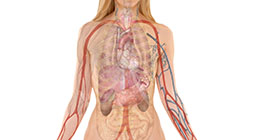
Imagine two foods on a table in front of you. The first is a hardboiled egg, the second is a white cupcake with chocolate icing. How would these foods be broken down in your body? The protein-rich egg would slowly and steadily be digested without a spike in blood glucose (sugar). The pancreas would be triggered to produce normal amounts of insulin to assist glucose uptake into cells. That cellular uptake would be equally gradual, and you would experience an even energy level until the next influx of food, hopefully an equally healthy choice.
Since glucose is the main fuel for our brain (the heart’s main source is fatty acids), it is important to balance our blood sugar in a way that supplies the body’s demands. Imagine what happens when you eat the cupcake. The refined flour, void of fiber and nutrients, is used by the body in the same way as pure sugar. It hits the bloodstream quickly, demanding an influx of insulin from the pancreas, which pumps out the hormone needed to shuttle glucose into cells. The cells take a huge sugar hit, resulting in a “sugar high” that leaves you buzzing. Before you know it, that quick burst of energy is gone. You are exhausted, yet you are left craving the next sugary sweet.
Steady Sugar Destruction
The cumulative effect of unhealthy food choices is destructive. If you indulge in a steady supply of high-sugar and/or high-carbohydrate processed foods, your body systems are going to become overwhelmed. Your pancreas can get overworked and will stop producing the insulin you need. Or maybe your cells become less inclined to heed insulin’s call and slow the uptake of glucose, otherwise known as insulin resistance. One third of North Americans have some form of insulin resistance in which your fasting glucose level (the amount of sugar in your bloodstream after several hours of no food or drink) is higher than normal, but not high enough for a diabetes diagnosis. Over time, if you do not address this dangerous situation, your blood sugar and insulin will continue to rise and a type 2 diabetes diagnosis will result.
Type 1 diabetes accounts for 10 percent of cases and usually begins during childhood. In type 1 diabetics, the immune system has destroyed the beta cells of the pancreas that produce insulin, so daily insulin injections are required. Nine out of 10 cases of diabetes are of the type 2 variety, which used to be called adult-onset diabetes but is not any longer; many children and adolescents are now diagnosed with Type 2 diabetes due to overweight and obesity. Our pancreas, cells and heart can only take the stress of poor diet and lifestyle choices for so long. According to the American Diabetes Association, two out of every three people with diabetes die of some form of heart or blood vessel disease. The average type 2 diabetic lifespan is shortened by 10 to 15 years because of the cardiovascular side effects of diabetes.
Not Sweet for the Heart
It is misleading to focus solely on the “diabetic” effect on the heart. It would be more accurate to refer to the heart disease risks caused by all prediabetic states including insulin resistance, in which blood glucose levels are unnaturally high. According to a 2001 British Medical Journal study, even elevated blood glucose is a powerful predictor of heart disease.
Excess sugar in the blood damages blood vessels by contributing to the fat deposits on their walls, which, as we know, leads to atherosclerosis, blocked arteries and all too often, heart attacks and heart damage. Too much sugar also makes blood thicker and stickier, hindering the blood’s ability to deliver nutrients and oxygen to the cells. Circulation and blood flow slows — not a good thing considering how much energy and oxygen the heart needs to sustain its pumping effects.
When we have too much glucose in the blood, it triggers the liver to make more bad, very low-density lipoproteins (VLDL) that carry triglycerides (fats) in the blood and also cause free radical damage. Consequently, diabetes and other irregular blood sugar syndromes contribute to high triglycerides and increase bad cholesterol. At the same time, the amount of good HDL cholesterol in the body decreases. This combination of high triglycerides, high bad cholesterol and low good cholesterol puts us at risk for heart disease. The inflammation brigade also wants in on the action. Persistent irregular sugar regulation increases fibrinogen and C-reactive protein (CRP), higher levels of which increase artery clogging and heart attack. Type 2 diabetics are usually found to have CRP levels four times higher than those of non-diabetics.
Several gene variants increase the risk of both type 2 diabetes and coronary heart disease. For those with a genetic predisposition to these conditions, diet and lifestyle will be essential in avoiding a health crisis.
Metabolic Syndrome/Syndrome X
Metabolic syndrome, also known as syndrome X, insulin resistance syndrome, or Reaven’s syndrome, is a cluster of factors that puts people at risk for heart disease and type 2 diabetes; doubles our risk of heart attack; and multiplies our chance of developing type 2 diabetes five-fold. It is estimated that more than 30 percent of North Americans have this disorder, which is typified by a combination of three or more of the following traits and medical conditions: elevated waist circumference, high blood fats and sugar, high blood pressure and low HDL (good) cholesterol.
Sugar Speeds Aging
Yet another biochemical process related to (pre)diabetic states and heart disease — as well as premature aging — is glycation. When blood sugar binds to and chemically alters proteins and fats, damage occurs. These damaged molecules are called advanced glycation end (AGE) products and they interfere with the way cells work. They bind with collagen and make blood vessels stiff. They also promote blood clots by attracting blood platelets, encourage the oxidation of LDL cholesterol and create low-grade inflammation that promotes atherosclerosis.
Lifestyle Is the Best Drug
If you are even 15-20 pounds overweight, you could be at risk for diabetes and heart disease. Have a glucose tolerance test to determine how quickly glucose is cleared from your blood. ‘Normal’ blood values for the 75-gram oral glucose tolerance test that is used to check for type 2 diabetes are:
Fasting: 60-100 mg/dL
1 hour: <200 mg/dL
2 hours: <140 mg/dL. Between 140-200 mg/dL is considered impaired glucose tolerance (or prediabetes, when the body has become less sensitive to insulin and has to work harder to control blood glucose levels). This group is at increased risk for developing diabetes. Greater than 200 mg/dL is a sign of type 2 diabetes.
Sometimes, blood sugar problems that generate readings too low to be “diagnosed” by traditional tests go unaddressed and cause a variety of seemingly unrelated symptoms, including anxiety, fatigue, irritability and poor concentration. Tested or untested, everybody can benefit by working to keep blood sugars balanced and controlling the processes that create diabetes and related long-term complications such as kidney, eye and nerve damage.
Diabetes Prevention
In one compelling study on diabetes prevention, 3,200 non-diabetics with elevated blood sugar readings were placed into three groups: one taking a placebo, one taking a common insulin drug, and one with a lifestyle-modification program including two-and-a-half hours of exercise per week. After three years, diabetes incidence was 11 cases per 100 people in the placebo group, 8 per 100 in the drug group and 5 per 100 in the lifestyle/exercise group. In other words, while drug therapy was more effective than placebo at preventing diabetes, a change in lifestyle was the most effective. Diet and exercise intervention reduced the incidence of diabetes by 58 percent. Similar findings about lifestyle and exercise’s effect on diabetes prevention have been repeated since.
A recent study confirms that by taking steps to regulate blood sugar metabolism, we can also help stop heart disease in its tracks. More than 3,000 participants with impaired glucose tolerance were separated into three groups: one placebo group, one taking a common insulin drug, and one that underwent lifestyle modifications, including a calorie-restricted diet and moderate exercise. Over three years, tests were conducted to assess blood sugar changes and trends in risk factors for cardiovascular disease, including blood pressure, triglycerides and cholesterol levels. The researchers found that as glucose tolerance status deteriorated, cardiovascular risk factors went downhill as well. Conversely, when blood sugar regulation improved, the risk factors improved. The researchers concluded that changing your lifestyle is more effective than taking an insulin drug at improving your glucose tolerance profile and cardiovascular risk.
Clearly, heart disease and diabetes (and prediabetic states) are largely diseases created by poor choices. Let’s attack two killers with the power of an active lifestyle, supported by a healthy diet, targeted nutritional supplements, regular stress-reducing activities, and good mental/emotional health practices.











